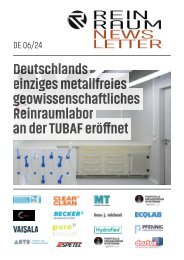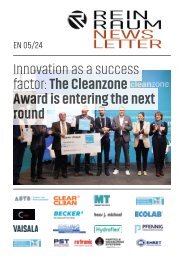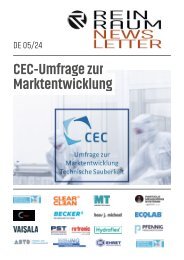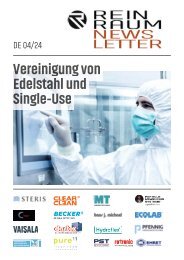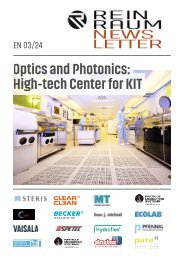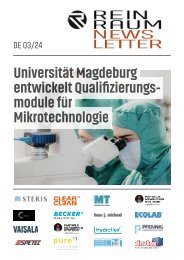Newsletter_04-2024_EN
You also want an ePaper? Increase the reach of your titles
YUMPU automatically turns print PDFs into web optimized ePapers that Google loves.
© iStock/1358567925/PeopleImages
© iStock/1298111593/Eplisterra
are usually so-called cobots, short for collaborative robots. Their advantage
is that they can be safely integrated into a shared workspace
with a human, without the need for physical separation.
It is conceivable that in the future, robotic assistants will take
over simple and tedious tasks from laboratory staff. „Kevin“, an autonomous
cobot developed by the Fraunhofer Institute for Automation
Technology, is already in use in real laboratories. This cobot moves
independently around the laboratory, taking samples and transporting
them between the reception area, the analysis laboratory and the
archive. According to automation expert Thurow, this type of mobile
robot has the best chance of fundamentally changing laboratory
work in the future. „It will further increase the degree of automation,
especially in highly complex distributed systems. However, she believes
that there will never be a fully autonomous laboratory. „Solutions
will always be tailored to specific processes,“ says Thurow.
Flood of data
Apart from the physical tasks performed by robots and other machines,
data generation is usually the main focus, or at least an essential
part of the work, in the laboratory context. Since the beginning of
the computer age, we have seen a rapid increase in the speed and
volume of data generated.
This has inevitably been accompanied by the development of
tools to assist laboratory staff in the acquisition, maintenance and
analysis of data. These include laboratory information and management
systems (LIMS), which would probably not exist without the
growing flow of data. These systems help with documentation, sample
management and act as an interface to the various instruments
used in the laboratory. This makes process and sample traceability
easier or possible, allowing accredited laboratories to comply with
regulations at a reasonable cost.
Communication is key
In general, interfaces are an extremely important issue in the laboratory
world. For some time now, there have been efforts to put an end
to the days of proprietary software and to enable the much-vaunted
„plug and play“ capability across different manufacturers without
any restrictions – in other words, simply plug in a new spectrometer
and it is immediately recognised in the existing laboratory network
and ready for use. Although this is already happening in many cases,
there is still much to be done. The two initiatives SiLA and OPC UA
LADS are particularly noteworthy in this respect. Both aim to create
a common standard for instrument connectivity in the laboratory.
One reality is not enough
When it comes to the usability of a new or first-time laboratory setup,
it is not just the question of interfaces that comes into play, but
also general planning aspects such as the sensible location of equipment,
the space available and even the complete planning of media
supply and the set-up of new workstations. Virtual reality (VR) has
already gained a foothold in the laboratory sector. For example, a
pre-created digital twin of the laboratory can be explored interactively
and immersively, laboratory furniture can be placed and modified,
and users can discuss and visualise changes with the laboratory
planners in the virtual space. This transforms traditional site visits
into meetings that can be held from anywhere by simply logging in –
provided there is a stable internet connection.
A related technology, Augmented Reality (AR), superimposes
digital information on the user‘s view of the real world. This technology
has great potential to improve the quality of work in the laboratory,
although it is still a long way from being used in everyday
work. The possibilities are endless: step-by-step workflows guided
by text displayed in data glasses, highlighting of required equipment
or chemicals in the field of view, or repair instructions for an analytical
instrument are just a few examples. Users may still have to get
used to this form of assistance. It is conceivable that this technology
will soon become socially acceptable in the wake of Apple‘s recently
introduced VR glasses.
When machines start to learn
The emergence of the ChatGPT chatbot and its clones, which have
generated a huge media hype in a very short time, shows how quickly
a technological leap can take place. The possibilities offered by such
learning algorithms will also change the world of laboratory work. A
suitably trained programme could, for example, help with documentation
and writing publications. Or it could simply act as an intermediary
between humans and computer programmes, allowing them to
design and control measurements via text or voice input – in direct
dialogue with the analytical instrument, so to speak. In 2022, Lauda,
the manufacturer of temperature control technology, made its first
attempts at voice control for the laboratory with its Lauda Live system.
The advantage is obvious: manual data entry is no longer necessary,
leaving the hands free for other tasks.
The green lab of the future
Laboratories will gradually become more connected, digitalised and
www.reinraum.de | www.cleanroom-online.com NEWSLETTER | Edition EN 04-2024
page 32/35









